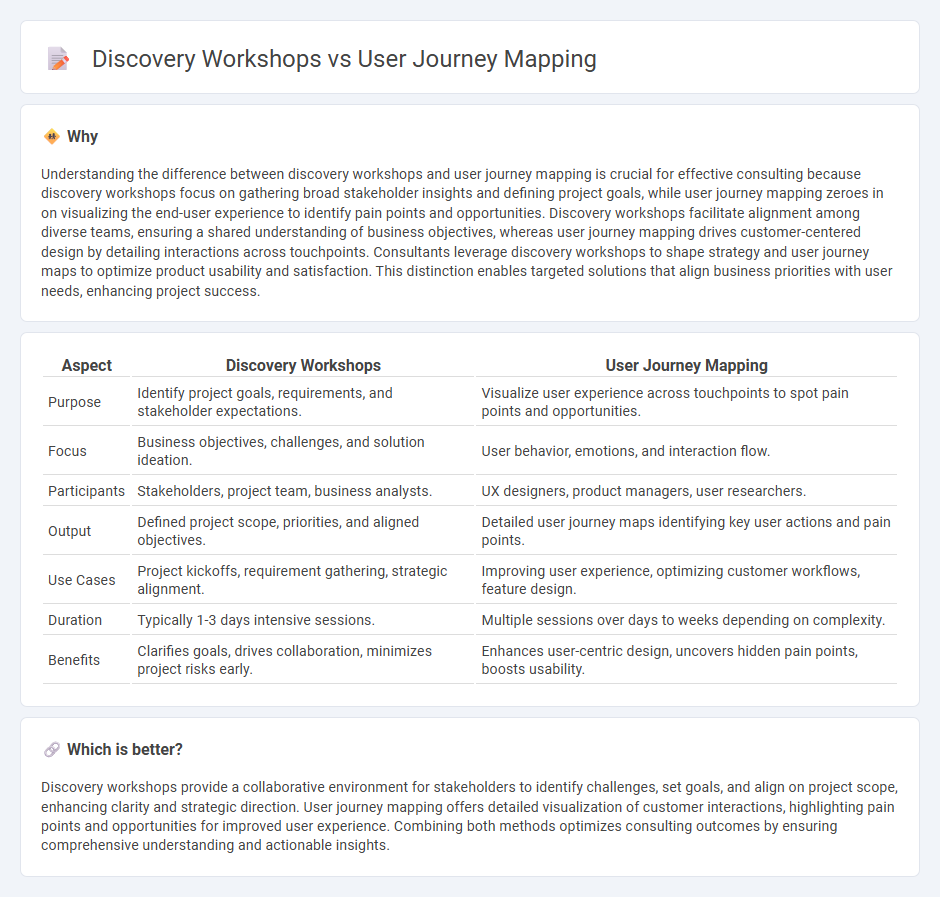
Discovery workshops facilitate collaborative problem-solving by bringing stakeholders together to identify business needs, define goals, and align expectations efficiently. User journey mapping provides a detailed visualization of customer interactions across touchpoints, enabling deeper insights into pain points and opportunities for enhanced user experience. Explore the distinct advantages of discovery workshops and user journey mapping to optimize your consulting strategy.
Why it is important
Understanding the difference between discovery workshops and user journey mapping is crucial for effective consulting because discovery workshops focus on gathering broad stakeholder insights and defining project goals, while user journey mapping zeroes in on visualizing the end-user experience to identify pain points and opportunities. Discovery workshops facilitate alignment among diverse teams, ensuring a shared understanding of business objectives, whereas user journey mapping drives customer-centered design by detailing interactions across touchpoints. Consultants leverage discovery workshops to shape strategy and user journey maps to optimize product usability and satisfaction. This distinction enables targeted solutions that align business priorities with user needs, enhancing project success.
Comparison Table
| Aspect | Discovery Workshops | User Journey Mapping |
|---|---|---|
| Purpose | Identify project goals, requirements, and stakeholder expectations. | Visualize user experience across touchpoints to spot pain points and opportunities. |
| Focus | Business objectives, challenges, and solution ideation. | User behavior, emotions, and interaction flow. |
| Participants | Stakeholders, project team, business analysts. | UX designers, product managers, user researchers. |
| Output | Defined project scope, priorities, and aligned objectives. | Detailed user journey maps identifying key user actions and pain points. |
| Use Cases | Project kickoffs, requirement gathering, strategic alignment. | Improving user experience, optimizing customer workflows, feature design. |
| Duration | Typically 1-3 days intensive sessions. | Multiple sessions over days to weeks depending on complexity. |
| Benefits | Clarifies goals, drives collaboration, minimizes project risks early. | Enhances user-centric design, uncovers hidden pain points, boosts usability. |
Which is better?
Discovery workshops provide a collaborative environment for stakeholders to identify challenges, set goals, and align on project scope, enhancing clarity and strategic direction. User journey mapping offers detailed visualization of customer interactions, highlighting pain points and opportunities for improved user experience. Combining both methods optimizes consulting outcomes by ensuring comprehensive understanding and actionable insights.
Connection
Discovery workshops uncover user needs and business goals, forming the foundation for user journey mapping by providing detailed insights into customer behaviors and pain points. User journey mapping visualizes these insights, enabling consultants to identify friction points and opportunities for enhancement across touchpoints. This iterative process aligns stakeholder perspectives, driving targeted solutions and improving overall user experience in consulting projects.
Key Terms
Personas
User journey mapping visualizes customer interactions and pain points across touchpoints, emphasizing a detailed understanding of personas' needs and motivations. Discovery workshops gather cross-functional teams to collaboratively identify user problems, prioritize features, and align on solutions centered around persona insights. Explore how integrating both methods enhances user-focused design and drives product success.
Touchpoints
User journey mapping emphasizes identifying and analyzing customer touchpoints across all stages of interaction to optimize overall experience and satisfaction. Discovery workshops prioritize collaborative exploration of customer needs and pain points to uncover critical touchpoints that may be overlooked. Explore how focusing on touchpoints in both methods can enhance customer-centric strategies and deliver actionable insights.
Pain Points
User journey mapping identifies pain points by visualizing each interaction a user has with a product or service, revealing specific moments of frustration or confusion. Discovery workshops gather diverse stakeholder insights to collaboratively uncover unspoken user pain points and align on priorities for improvement. Explore how both approaches can optimize problem-solving and enhance user experience by diving deeper into their methodologies.
Source and External Links
User Journey Mapping: What is it & How to do it - Figma - A user journey map is a visual tool that centers on how a user persona interacts with a product's functionality to uncover pain points and improve usability by focusing on key components like user persona, scenario, and objective.
What is UX Journey Mapping? - Qualtrics - A user journey map visually outlines the steps a user takes to achieve a goal, breaking down the experience into stages or phases such as discovery, trial, purchase, usage, support, and repurchase.
Journey Mapping 101 - NN/g - Journey mapping visualizes a person's process to accomplish a goal by mapping journey phases, user actions, mindsets, emotions, and identifying opportunities for improving the experience.
 dowidth.com
dowidth.com